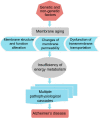Membrane Aging as the Real Culprit of Alzheimer's Disease: Modification of a Hypothesis
- PMID: 29177767
- PMCID: PMC5856718
- DOI: 10.1007/s12264-017-0192-4
Membrane Aging as the Real Culprit of Alzheimer's Disease: Modification of a Hypothesis
Abstract
Our previous studies proposed that Alzheimer's disease (AD) is a metabolic disorder and hypothesized that abnormal brain glucose metabolism inducing multiple pathophysiological cascades contributes to AD pathogenesis. Aging is one of the great significant risk factors for AD. Membrane aging is first prone to affect the function and structure of the brain by impairing glucose metabolism. We presume that risk factors of AD, including genetic factors (e.g., the apolipoprotein E ε4 allele and genetic mutations) and non-genetic factors (such as fat, diabetes, and cardiac failure) accelerate biomembrane aging and lead to the onset and development of the disease. In this review, we further modify our previous hypothesis to demonstrate "membrane aging" as an initial pathogenic factor that results in functional and structural alterations of membranes and, consequently, glucose hypometabolism and multiple pathophysiological cascades.
Keywords: Alzheimer’s disease; Amyloid-β; Membrane aging; Thiamine.
Figures

References
Publication types
MeSH terms
LinkOut - more resources
Full Text Sources
Other Literature Sources
Medical

